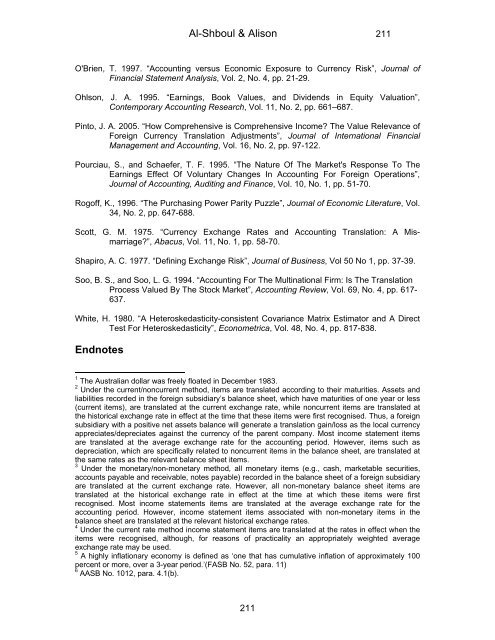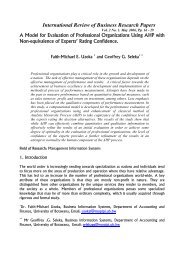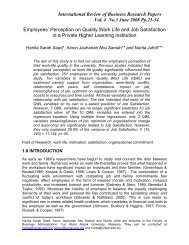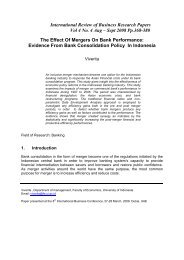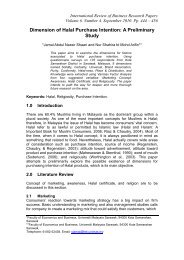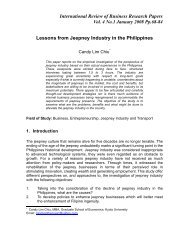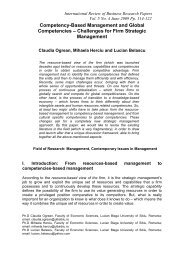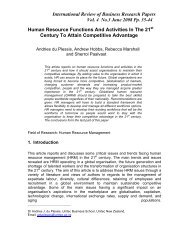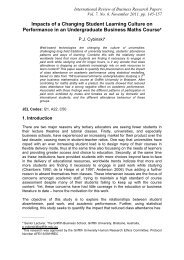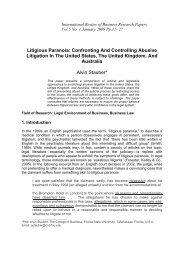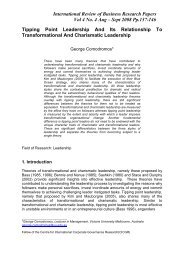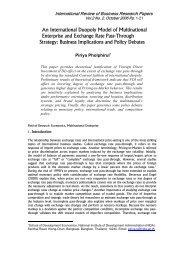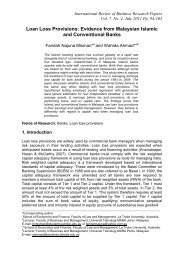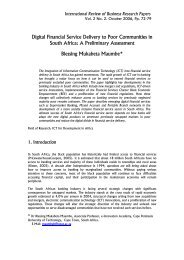Translation Exposure and Firm Value, Evidence From Australian ...
Translation Exposure and Firm Value, Evidence From Australian ...
Translation Exposure and Firm Value, Evidence From Australian ...
Create successful ePaper yourself
Turn your PDF publications into a flip-book with our unique Google optimized e-Paper software.
Al-Shboul & Alison 211O'Brien, T. 1997. “Accounting versus Economic <strong>Exposure</strong> to Currency Risk”, Journal ofFinancial Statement Analysis, Vol. 2, No. 4, pp. 21-29.Ohlson, J. A. 1995. “Earnings, Book <strong>Value</strong>s, <strong>and</strong> Dividends in Equity Valuation”,Contemporary Accounting Research, Vol. 11, No. 2, pp. 661–687.Pinto, J. A. 2005. “How Comprehensive is Comprehensive Income? The <strong>Value</strong> Relevance ofForeign Currency <strong>Translation</strong> Adjustments”, Journal of International FinancialManagement <strong>and</strong> Accounting, Vol. 16, No. 2, pp. 97-122.Pourciau, S., <strong>and</strong> Schaefer, T. F. 1995. “The Nature Of The Market's Response To TheEarnings Effect Of Voluntary Changes In Accounting For Foreign Operations”,Journal of Accounting, Auditing <strong>and</strong> Finance, Vol. 10, No. 1, pp. 51-70.Rogoff, K., 1996. “The Purchasing Power Parity Puzzle”, Journal of Economic Literature, Vol.34, No. 2, pp. 647-688.Scott, G. M. 1975. “Currency Exchange Rates <strong>and</strong> Accounting <strong>Translation</strong>: A Mismarriage?”,Abacus, Vol. 11, No. 1, pp. 58-70.Shapiro, A. C. 1977. “Defining Exchange Risk”, Journal of Business, Vol 50 No 1, pp. 37-39.Soo, B. S., <strong>and</strong> Soo, L. G. 1994. “Accounting For The Multinational <strong>Firm</strong>: Is The <strong>Translation</strong>Process <strong>Value</strong>d By The Stock Market”, Accounting Review, Vol. 69, No. 4, pp. 617-637.White, H. 1980. “A Heteroskedasticity-consistent Covariance Matrix Estimator <strong>and</strong> A DirectTest For Heteroskedasticity”, Econometrica, Vol. 48, No. 4, pp. 817-838.Endnotes1 The <strong>Australian</strong> dollar was freely floated in December 1983.2 Under the current/noncurrent method, items are translated according to their maturities. Assets <strong>and</strong>liabilities recorded in the foreign subsidiary’s balance sheet, which have maturities of one year or less(current items), are translated at the current exchange rate, while noncurrent items are translated atthe historical exchange rate in effect at the time that these items were first recognised. Thus, a foreignsubsidiary with a positive net assets balance will generate a translation gain/loss as the local currencyappreciates/depreciates against the currency of the parent company. Most income statement itemsare translated at the average exchange rate for the accounting period. However, items such asdepreciation, which are specifically related to noncurrent items in the balance sheet, are translated atthe same rates as the relevant balance sheet items.3 Under the monetary/non-monetary method, all monetary items (e.g., cash, marketable securities,accounts payable <strong>and</strong> receivable, notes payable) recorded in the balance sheet of a foreign subsidiaryare translated at the current exchange rate. However, all non-monetary balance sheet items aretranslated at the historical exchange rate in effect at the time at which these items were firstrecognised. Most income statements items are translated at the average exchange rate for theaccounting period. However, income statement items associated with non-monetary items in thebalance sheet are translated at the relevant historical exchange rates.4 Under the current rate method income statement items are translated at the rates in effect when theitems were recognised, although, for reasons of practicality an appropriately weighted averageexchange rate may be used.5 A highly inflationary economy is defined as ‘one that has cumulative inflation of approximately 100percent or more, over a 3-year period.’(FASB No. 52, para. 11)6 AASB No. 1012, para. 4.1(b).211


